You are using an out of date browser. It may not display this or other websites correctly.
You should upgrade or use an alternative browser.
You should upgrade or use an alternative browser.
TSDZ2 mid drive with 860C, 850C or SW102 displays only -- Flexible OpenSource firmware (Casainho code only)
- Thread starter casainho
- Start date
casainho
10 GW
- Joined
- Feb 14, 2011
- Messages
- 6,045
Update to version 1.0.0 or ask on another thread.winwar84 said:hello, with firmware 0.20.0 I soldered the temperature sensor to the controller. can I eliminate it and use the same cables to put the accelerator? thanks
HughF
100 W
One of the benefits of the ANT+/BTLE project that Casainho is working on would be the ability to move the %SOC tracking to a SmartBMS and read that value over the Bluetooth connection into the NRF PCB... Full %SOC tracking would then be possible on charge and discharge.vshitikov said:izeman said:I'm just doing it. One more question: Does the firmware build an internal table to compare voltage and SOC once it's done one full cycle? Or do you need to always recharge it to reset to counter and set SOC to 100%? What I mean: Will the SOC% be accurate even if i only charge, let's say from 20% to 70% (after the initial charge/discharge)? I guess so?!casainho said:Yes, go ahead and improve the information that could help you and then it will help the next ones.
I don't think it will be accurate. The firmware waits till the voltage crosses the threshold, that you have configured, to reset the gauge to 100%. If you didn't reach the threshold while charging the firmware will keep substracting Watt hours and will show 0%. So you must recharge it fully to reset the counter. If you don't want to fully recharge the battery - say 90%, you may set your threshold lower so it resets while charged to 90%.
This handling is not ideal but I guess it's the only one possible if you don't have a smart BMS that communicates with your display.
casainho
10 GW
- Joined
- Feb 14, 2011
- Messages
- 6,045
I use the Bluetooth SmartBMS on some of my bicycles and sometimes it is really important to check how is the voltage of each cells. I had issues before with my battery pack or TSDZ2 and looking at that information is important. This BMS also logs the voltages and currents, it is nice to see the history when trying to debug the issues I had.HughF said:One of the benefits of the ANT+/BTLE project that Casainho is working on would be the ability to move the %SOC tracking to a SmartBMS and read that value over the Bluetooth connection into the NRF PCB... Full %SOC tracking would then be possible on charge and discharge.
Theoretically the ANT+/BLE could connect to this cheap and popular BMS and have this information, SOC, disable the battery power, etc, and show to user on the display or mobile phone.
HughF
100 W
I am about to build a new battery pack and will use the Bluetooth smart bms.casainho said:I use the Bluetooth SmartBMS on some of my bicycles and sometimes it is really important to check how is the voltage of each cells. I had issues before with my battery pack or TSDZ2 and looking at that information is important. This BMS also logs the voltages and currents, it is nice to see the history when trying to debug the issues I had.HughF said:One of the benefits of the ANT+/BTLE project that Casainho is working on would be the ability to move the %SOC tracking to a SmartBMS and read that value over the Bluetooth connection into the NRF PCB... Full %SOC tracking would then be possible on charge and discharge.
Theoretically the ANT+/BLE could connect to this cheap and popular BMS and have this information, SOC, disable the battery power, etc, and show to user on the display or mobile phone.
izeman
1 GW
I'm not sure how using the BMS' information to determine SOC would help. Eg the BT SmartBMS that I have installed on most of my batteries (and the one that's refered here too) as well isn't very good at SOC determination either. YOU have to enter cell voltage values for 100%, 80%,60%,40%, 20% and 0%. Those are then used to build the graph you see on the main page.casainho said:I use the Bluetooth SmartBMS on some of my bicycles and sometimes it is really important to check how is the voltage of each cells. I had issues before with my battery pack or TSDZ2 and looking at that information is important. This BMS also logs the voltages and currents, it is nice to see the history when trying to debug the issues I had.HughF said:One of the benefits of the ANT+/BTLE project that Casainho is working on would be the ability to move the %SOC tracking to a SmartBMS and read that value over the Bluetooth connection into the NRF PCB... Full %SOC tracking would then be possible on charge and discharge.
Theoretically the ANT+/BLE could connect to this cheap and popular BMS and have this information, SOC, disable the battery power, etc, and show to user on the display or mobile phone.
Something like this could easily be setup in the firmware as well. 6 user defined values (full, 80,60,40,20, empty) and that's it. All other values are interpolated. Add the great Wh gauge and you have a super nice SOC meter.
I use the app to check for individual cell (string) level and maybe to disable the battery completely or do a manual balance if needed.
HughF
100 W
The smart BMS doesn't have a shunt? Lame...izeman said:I'm not sure how using the BMS' information to determine SOC would help. Eg the BT SmartBMS that I have installed on most of my batteries (and the one that's refered here too) as well isn't very good at SOC determination either. YOU have to enter cell voltage values for 100%, 80%,60%,40%, 20% and 0%. Those are then used to build the graph you see on the main page.casainho said:I use the Bluetooth SmartBMS on some of my bicycles and sometimes it is really important to check how is the voltage of each cells. I had issues before with my battery pack or TSDZ2 and looking at that information is important. This BMS also logs the voltages and currents, it is nice to see the history when trying to debug the issues I had.HughF said:One of the benefits of the ANT+/BTLE project that Casainho is working on would be the ability to move the %SOC tracking to a SmartBMS and read that value over the Bluetooth connection into the NRF PCB... Full %SOC tracking would then be possible on charge and discharge.
Theoretically the ANT+/BLE could connect to this cheap and popular BMS and have this information, SOC, disable the battery power, etc, and show to user on the display or mobile phone.
Something like this could easily be setup in the firmware as well. 6 user defined values (full, 80,60,40,20, empty) and that's it. All other values are interpolated. Add the great Wh gauge and you have a super nice SOC meter.
I use the app to check for individual cell (string) level and maybe to disable the battery completely or do a manual balance if needed.
izeman
1 GW
Sure it has. For charge and for discharge. But the TSDZ2 can measure current as well.HughF said:The smart BMS doesn't have a shunt? Lame...
My point was, that the BMS has no better knowledge of SOC than the TSDZ2 can have (it knows SOC per cell, but we don't need that info for a general SOC-bar-meter)
casainho
10 GW
- Joined
- Feb 14, 2011
- Messages
- 6,045
Battery BMS as the best knowledge of battery SOC because it measures both charging and discharging power, and charging cycles init and stop.izeman said:Sure it has. For charge and for discharge. But the TSDZ2 can measure current as well.HughF said:The smart BMS doesn't have a shunt? Lame...
My point was, that the BMS has no better knowledge of SOC than the TSDZ2 can have (it knows SOC per cell, but we don't need that info for a general SOC-bar-meter)
HughF
100 W
The BMS has a much better idea of the SOC, because the charger connects to the BMS. So for people who hover their SOC between a certain percentage window, the BMS will always give a better indication of SOC.izeman said:Sure it has. For charge and for discharge. But the TSDZ2 can measure current as well.HughF said:The smart BMS doesn't have a shunt? Lame...
My point was, that the BMS has no better knowledge of SOC than the TSDZ2 can have (it knows SOC per cell, but we don't need that info for a general SOC-bar-meter)
The TSDZ2 knows nothing of the aH going back into the battery so it cannot account for them and increase it's coulomb counter back towards 100%. It can only count discharge aH and measure battery voltage. That might be fine for a LiMnCo or similar chemistry pack where you could back calculate SOC based on battery voltage, but is useless for LiFePo4 users who have a really flat discharge curve.
James Broadhurst
100 W
Would you let me/us know where you got it from? A year ago I fitted one and it worked fine until I came back from a holiday and it had drained a 600whr battery flat. Seems that it kept looking for a blue tooth signal!HughF said:I am about to build a new battery pack and will use the Bluetooth smart bms.
izeman
1 GW
In theory you are 100% correct. But I highly doubt that this is how the smartbms we are talking about does it. If it really did coulomb counting in and out there were no need to enter voltage values for 0-100%. The BMS knew it way better, and would act like casinho's method: reset the counter at eg 4.2V per cell and call that a full battery. Then start deducting Wh/Ah from this value.HughF said:The BMS has a much better idea of the SOC, because the charger connects to the BMS. So for people who hover their SOC between a certain percentage window, the BMS will always give a better indication of SOC.
The TSDZ2 knows nothing of the aH going back into the battery so it cannot account for them and increase it's coulomb counter back towards 100%. It can only count discharge aH and measure battery voltage. That might be fine for a LiMnCo or similar chemistry pack where you could back calculate SOC based on battery voltage, but is useless for LiFePo4 users who have a really flat discharge curve.
But this, as mentioned, is highly questionable.
That's why i still doubt that we can expect any better results from an ANT/BT connection to the BMS, but just replicate the SOC algorithm like the cheap BMS does it.
This of course are just my thoughts and observation, I haven't seen and source code of the BMS' firmware.
Of course LiFePo4 is another chapter - SOC there is always a pita judging by voltage
HughF
100 W
If this is indeed how the so-called SmartBMS does it's SOC calculations then they are not so smart after all. I am used to batrium, and an outback FlexnetDC, both measuring all power in and out of their respective shunts, so I just assumed the SmartBMS did the same.izeman said:In theory you are 100% correct. But I highly doubt that this is how the smartbms we are talking about does it. If it really did coulomb counting in and out there were no need to enter voltage values for 0-100%. The BMS knew it way better, and would act like casinho's method: reset the counter at eg 4.2V per cell and call that a full battery. Then start deducting Wh/Ah from this value.HughF said:The BMS has a much better idea of the SOC, because the charger connects to the BMS. So for people who hover their SOC between a certain percentage window, the BMS will always give a better indication of SOC.
The TSDZ2 knows nothing of the aH going back into the battery so it cannot account for them and increase it's coulomb counter back towards 100%. It can only count discharge aH and measure battery voltage. That might be fine for a LiMnCo or similar chemistry pack where you could back calculate SOC based on battery voltage, but is useless for LiFePo4 users who have a really flat discharge curve.
But this, as mentioned, is highly questionable.
That's why i still doubt that we can expect any better results from an ANT/BT connection to the BMS, but just replicate the SOC algorithm like the cheap BMS does it.
This of course are just my thoughts and observation, I haven't seen and source code of the BMS' firmware.
Of course LiFePo4 is another chapter - SOC there is always a pita judging by voltage
Hmmm.... back to voltage based SOC then
HughF
100 W
I don't have it in my hand yet, but it will be the cheapest, nastiest deal I can get from AliExpressJames Broadhurst said:Would you let me/us know where you got it from? A year ago I fitted one and it worked fine until I came back from a holiday and it had drained a 600whr battery flat. Seems that it kept looking for a blue tooth signal!HughF said:I am about to build a new battery pack and will use the Bluetooth smart bms.
izeman
1 GW
I will do some testing so we KNOW and don't have to ASSUME anymoreHughF said:If this is indeed how the so-called SmartBMS does it's SOC calculations then they are not so smart after all. I am used to batrium, and an outback FlexnetDC, both measuring all power in and out of their respective shunts, so I just assumed the SmartBMS did the same.
Hmmm.... back to voltage based SOC then
Did some test riding and these are the results (as expected):
The battery was fully charged yesterday evening and then a litte ride to bring voltage a little down:
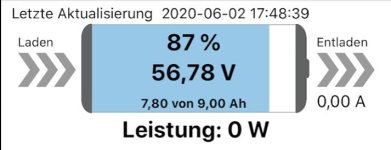
Here's the display of the 850C:

and these are the settings of the BMS:

I then changed the settings to some completely OFF value, trying to see if this would change the SOC meter somehow
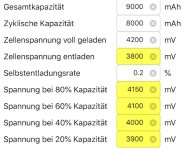
and YES, it did change. It shows SOC purely based on voltage reading:
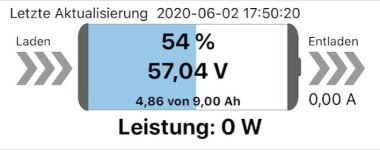
I then connected my charger to see how the SOC would change. Please note the "remaining Ah" - it's 4.77Ah left from 9.00Ah (went down by 3Ah)
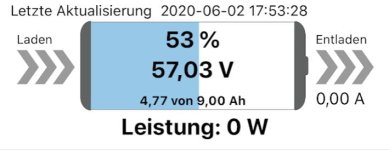
After 0.2Ah charged
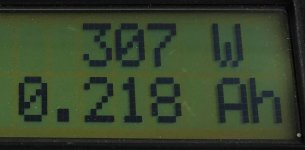
this is the result
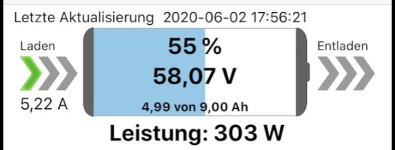
4.99Ah - so it adds up the energy charged, but the meter shows the wrong SOC. Would be interesting to see if the CPU explodes once it realizes that it can charge more Ah then the battery should be able to hold
PS: Re-read the whole post twice now. Noted a thing: I charged 0.2Ah, the BMS shows this correclty (from 4.7 left to 4.9 left) and SOC went from 53% to 55% (added 2%). And 2% = 1/50th of battery capacity. 50x 0.2Ah = 10Ah, which is the correct capacity.
State of Charge tracking is a huge challenge to get accurate, requires all sorts of data kept up to date by the owner, not least changing Ah capacity, but also CEF and Peukert coefficient.
Dedicated instruments costing hundreds have a hard time remaining even within 6-10% of actual SoC.
I doubt done properly by most BMS
Dedicated instruments costing hundreds have a hard time remaining even within 6-10% of actual SoC.
I doubt done properly by most BMS
I must be missing something, but why all the worry about state of charge. I honestly go by the current voltage to know how much battery i have left. You already stated that you regularly only charge to like 50%, so why not just charge to 80% and then you would not even need to worry about it. If you knew that you were fine with 50% for your ride then with 80% it would be a non issue. Worse case you look at your current Voltage and you can get a great idea of how much juice you have left.
I might understand it if you have a small pack like my wife, but even with her's I have never had an issue tracking the voltage. With most packs I judge things over time by going a certain usage then recharging and seeing how low I was, after awhile I can get a great idea of exactly what is in the pack and where I need to stop.
Sorry if I am wrong but it seems that tracking the SOC is very complex and not terribly reliable. Am I missing something? Again, truly curious, not wanting to offend anyone.
I might understand it if you have a small pack like my wife, but even with her's I have never had an issue tracking the voltage. With most packs I judge things over time by going a certain usage then recharging and seeing how low I was, after awhile I can get a great idea of exactly what is in the pack and where I need to stop.
Sorry if I am wrong but it seems that tracking the SOC is very complex and not terribly reliable. Am I missing something? Again, truly curious, not wanting to offend anyone.
john61ct said:State of Charge tracking is a huge challenge to get accurate, requires all sorts of data kept up to date by the owner, not least changing Ah capacity, but also CEF and Peukert coefficient.
Dedicated instruments costing hundreds have a hard time remaining even within 6-10% of actual SoC.
I doubt done properly by most BMS
I agree. We cannot get better than 10%. There are so many factors that come in play and the dominant factor is ambient temperature. The system that would estimate properly will cost hundreds and will drain your battery because the MCU will have to keep acquiring sensors and integrating
For the best hill start performance I would setup as the following:
Motor current control = torque
Assist w/o pedal = enable
Startup BOOST = disable
Startup BOOST duration = 5
Startup BOOST fade = 6.5
Motor current ramp = 10a (maximum)
Calibrate your torque sensor then enable calibrations
Motor current max = 20a
Soo I installed this programming, and I have to say it feels way way better. i think one could say it feels close to a Levo. Mind you it is still way louder than a levo, but my wallet is still stuffed.....
Now, can anyone tell me more about the throttle? I have the temp sensor turned off and turned to throttle, but the throttle is very sluggish, if I am climbing a hill and I push it it is useless it takes forever to ramp up. Do I have to turn on the virtual tharottle in the street mode(which I have turned off)?
Motor current control = torque
Assist w/o pedal = enable
Startup BOOST = disable
Startup BOOST duration = 5
Startup BOOST fade = 6.5
Motor current ramp = 10a (maximum)
Calibrate your torque sensor then enable calibrations
Motor current max = 20a
Soo I installed this programming, and I have to say it feels way way better. i think one could say it feels close to a Levo. Mind you it is still way louder than a levo, but my wallet is still stuffed.....
Now, can anyone tell me more about the throttle? I have the temp sensor turned off and turned to throttle, but the throttle is very sluggish, if I am climbing a hill and I push it it is useless it takes forever to ramp up. Do I have to turn on the virtual tharottle in the street mode(which I have turned off)?
cavi said:For the best hill start performance I would setup as the following:
Motor current control = torque
Assist w/o pedal = enable
Startup BOOST = disable
Startup BOOST duration = 5
Startup BOOST fade = 6.5
Motor current ramp = 10a (maximum)
Calibrate your torque sensor then enable calibrations
Motor current max = 20a
Soo I installed this programming, and I have to say it feels way way better. i think one could say it feels close to a Levo. Mind you it is still way louder than a levo, but my wallet is still stuffed.....
Now, can anyone tell me more about the throttle? I have the temp sensor turned off and turned to throttle, but the throttle is very sluggish, if I am climbing a hill and I push it it is useless it takes forever to ramp up. Do I have to turn on the virtual tharottle in the street mode(which I have turned off)?
I second this question. The throttle has always been anemic. What can we do to get true and direct motor current control from the throttle?
Yesterday i suddenly encountered a short, steep uphill road in the dark. When I realised that the gear would not be sufficient, I quickly pushed the assistance from 8 to 13 while already climbing. I would have expected to get more support, but actually I did not feel this. I hardly made it up to the top of the road and my impression was the motor did not want to react to the increased assistance level, I the contrary, it hardly did anything, was my feeling. I was surprised about this behaviour, I think in the past that would have worked this way...? 
Later I had a somewhat similar situation but I was able to shift down and get more cadence and the support of the motor was there again.
Is it possible that the motor has problems to support under pressure with low cadence?
I am using torque mode.
Later I had a somewhat similar situation but I was able to shift down and get more cadence and the support of the motor was there again.
Is it possible that the motor has problems to support under pressure with low cadence?
I am using torque mode.
andyme said:Yesterday i suddenly encountered a short, steep uphill road in the dark. When I realised that the gear would not be sufficient, I quickly pushed the assistance from 8 to 13 while already climbing. I would have expected to get more support, but actually I did not feel this. I hardly made it up to the top of the road and my impression was the motor did not want to react to the increased assistance level, I the contrary, it hardly did anything, was my feeling. I was surprised about this behaviour, I think in the past that would have worked this way...?
Later I had a somewhat similar situation but I was able to shift down and get more cadence and the support of the motor was there again.
Is it possible that the motor has problems to support under pressure with low cadence?
I am using torque mode.
Well, if you reached your maximum current already - the motor won't give you more than you already getting. I reach my 16amps pretty quickly on climbs.
I also think that current implementation of the motor control does not give full torque at 0RPM (i'm using a version 0.8 still) But I did't have time to run tests to prouve that.
Anyways I always downshift on the hills, that's why we got the midle drive, otherwise I would install a cheaper and more reliable direct drive. We wouldn't want to climb a hill on a 5th gear with a car.
vshitikov said:andyme said:Yesterday i suddenly encountered a short, steep uphill road in the dark. When I realised that the gear would not be sufficient, I quickly pushed the assistance from 8 to 13 while already climbing. I would have expected to get more support, but actually I did not feel this. I hardly made it up to the top of the road and my impression was the motor did not want to react to the increased assistance level, I the contrary, it hardly did anything, was my feeling. I was surprised about this behaviour, I think in the past that would have worked this way...?
Later I had a somewhat similar situation but I was able to shift down and get more cadence and the support of the motor was there again.
Is it possible that the motor has problems to support under pressure with low cadence?
I am using torque mode.
Well, if you reached your maximum current already - the motor won't give you more than you already getting. I reach my 16amps pretty quickly on climbs.
I also think that current implementation of the motor control does not give full torque at 0RPM (i'm using a version 0.8 still) But I did't have time to run tests to prouve that.
Anyways I always downshift on the hills, that's why we got the midle drive, otherwise I would install a cheaper and more reliable direct drive. We wouldn't want to climb a hill on a 5th gear with a car.
I understand what you are saying. It happened unintentional. However it was my feeling that the motor did not react the way I expected it from my past experience with one yr old versions. That is what I wanted to convey. I was kind of surprised. Also it was not that steep.. I was at this place before with no problems maybe in other gears, but I did not expect this to happen, that is all I can say. Maybe there is something that is now different from before...
HughF
100 W
I'm glad that the settings worked well for you. I'm sorry that I cannot help with the throttle issue, I do not have a throttle on my bike.cavi said:For the best hill start performance I would setup as the following:
Motor current control = torque
Assist w/o pedal = enable
Startup BOOST = disable
Startup BOOST duration = 5
Startup BOOST fade = 6.5
Motor current ramp = 10a (maximum)
Calibrate your torque sensor then enable calibrations
Motor current max = 20a
Soo I installed this programming, and I have to say it feels way way better. i think one could say it feels close to a Levo. Mind you it is still way louder than a levo, but my wallet is still stuffed.....
Now, can anyone tell me more about the throttle? I have the temp sensor turned off and turned to throttle, but the throttle is very sluggish, if I am climbing a hill and I push it it is useless it takes forever to ramp up. Do I have to turn on the virtual tharottle in the street mode(which I have turned off)?
Similar threads
- Replies
- 4
- Views
- 913
- Replies
- 1
- Views
- 499
- Replies
- 207
- Views
- 26,550
- Replies
- 2,419
- Views
- 203,487
- Replies
- 0
- Views
- 649

